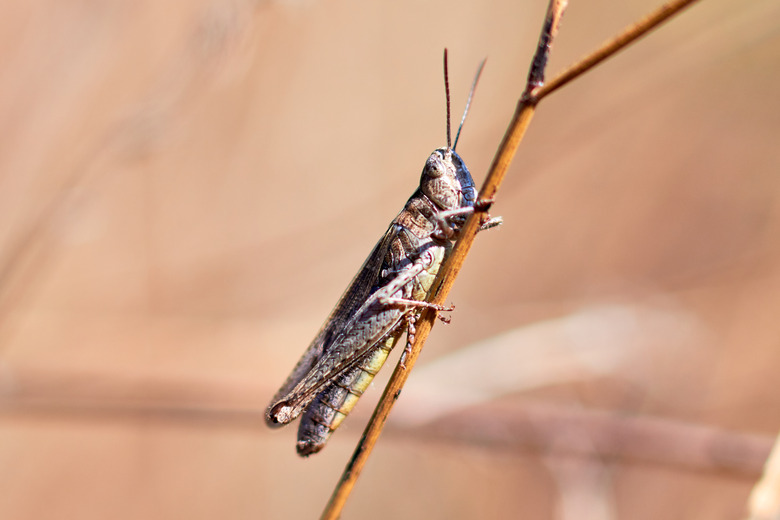Characteristics That Grasshoppers & Crayfish Share
Grasshoppers and crayfish, along with spiders, scorpions, lobsters, crabs and barnacles, belong to the phylum Arthropoda. Arthropods comprise the Earth's largest described animal phylum, including fossils dating back over 500 million years.
Grasshoppers and crayfish characteristics include the structures shared by all arthropods.
TL;DR (Too Long; Didn't Read)
Shared grasshopper and crayfish characteristics include chitinous exoskeletons, jointed legs, segmented bodies, compound eyes, digestive systems in a body cavity, nervous systems and open circulatory systems. They reproduce with eggs and molt as they grow. Grasshoppers and crayfish have two genders.
External Characteristics of Phylum Arthropoda
External Characteristics of Phylum Arthropoda
As invertebrates, arthropods lack backbones. Instead, arthropods have hard exoskeletons and jointed legs, antenna and other appendages.
"Arthropod" comes from the Greek words arthro, meaning joint, and pod, meaning foot. Most arthropods have a chitinous exoskeleton to protect their bodies, although some, like barnacles and crabs, excrete calcium carbonate to make a harder shell.
Because of the exoskeleton, arthropods must molt to grow. A new exoskeleton begins to develop beneath the hard outer exoskeleton, and then the outer exoskeleton splits. The arthropod wiggles out of the old shell, and the new exoskeleton expands. The new exoskeleton then hardens.
Segmented bodies also typify arthropods. Insects have three segments (head, thorax and abdomen) while many crustaceans have two body segments (cephalothorax, which is fused head and thorax, and abdomen).
Many arthropods have good vision due to well-developed compound eyes. Many also have excellent chemosensory abilities, meaning they sense and respond to chemicals in their environment. Taste and smell are two types of chemosensory stimuli.
Internal Characteristics of Phylum Arthropoda
Internal Characteristics of Phylum Arthropoda
Internally, arthropods have a complete digestive system with a coelom, or body cavity. Arthropods have a large ventral nerve cord connecting their brains with a network of nerves. Arthropods have open circulatory systems, meaning their hearts pump blood out through vessels, but the blood seeps back into the heart through pores.
Arthropods, unlike most invertebrates, have mostly striated muscles similar to vertebrate skeletal muscles. These muscles give arthropods greater strength and mobility.
Most arthropods have two separate sexes. Many arthropods go through a larval stage before undergoing metamorphosis to emerge in their adult form.
Grasshopper Characteristics
Grasshopper Characteristics
Grasshoppers belong to the class Insecta. Insects comprise 75 percent of identified animal species. Insects are found in almost all environments except deep sea habitats. Most insects, however, live on land.
As herbivores, grasshoppers can be quite destructive to plants. Occasionally grasshoppers eat dead insects for the extra protein.
External grasshopper anatomy exhibits a chitinous exoskeleton divided into three body segments (head, thorax and abdomen). The grasshopper's wings and three pairs of legs are attached to the thorax (middle segment). Grasshoppers have one pair of antennae on their heads.
Grasshoppers, like other insects, breathe through small openings called spiracles that lead to trachea tubes. These trachea tubes branch into smaller tracheoles that carry the air through the grasshoppers' bodies. Every movement of the grasshopper moves air through its body. Grasshoppers lack lung structures.
Grasshopper Reproduction
Grasshopper Reproduction
Grasshoppers hatch from eggs looking like tiny grasshoppers. They undergo incomplete metamorphosis, meaning each molt adds a few more adult characteristics. Most grasshoppers molt five to six times before maturity.
Grasshopper wings appear with the final molt. While eggs may overwinter, grasshoppers usually die when the weather turns cold. In warmer climates, predators, drought and disease control grasshopper populations.
Crayfish Characteristics
Crayfish Characteristics
Crayfish belong to the subphylum Crustacea. Most crustaceans live in the ocean, but the crayfish habitat is freshwater. Although freshwater crustaceans generally are called crayfish, different regions may argue that the name is crawfish or crawdads.
Crayfish are omnivores. Young crayfish eat 1 to 4 percent of their body weight every day and feed primarily on animals. Mature crayfish consume between 0.3 and 1 percent of their body weight each day and eat mostly plants.
External crayfish anatomy exhibits a chitinous exoskeleton with two body segments, a cephalothorax and an abdomen. Attached to the cephalothorax are four pairs of walking legs and a front pair of legs modified with large claws. Crayfish have two pairs of antennae.
Crayfish breathe using gills. If their aquatic environment dries up, however, they can estivate (a type of hibernation) in burrows or walk across land to find water.
Crayfish Reproduction
Crayfish Reproduction
Crayfish mate in early spring. The developing eggs remain inside the female crayfish for four to six weeks. The female then attaches the eggs to her tail using a special glue called glair. Only 20 to 40 percent of the eggs will hatch in late spring.
Crayfish molt six to 10 times during their first year of life but only three to five times during their second year. Most crayfish live about two years.
Grasshopper and Crayfish Comparison: Similarities
Grasshopper and Crayfish Comparison: Similarities
As members of Phylum Arthropoda, grasshoppers and crayfish share many characteristics. They both have a hard chitinous exoskeleton with jointed legs, segmented body, compound eyes, digestive system in a body cavity, nervous system and open circulatory systems.
Both grasshoppers and crayfish exhibit two genders. They both reproduce with eggs and must molt to grow.
Grasshopper and Crayfish Comparison: Differences
Grasshopper and Crayfish Comparison: Differences
Grasshoppers are terrestrial while crayfish are aquatic. Grasshoppers breathe through spiracles while crayfish use gills. Grasshoppers have three body segments, three pairs of legs, wings (most adults) and one pair of antennae.
Crayfish have two body segments, five pairs of legs (one modified to claws) and two pairs of antennae. Grasshoppers primarily are herbivores while crayfish are omnivores.
Cite This Article
MLA
Blaettler, Karen G. "Characteristics That Grasshoppers & Crayfish Share" sciencing.com, https://www.sciencing.com/characteristics-grasshoppers-crayfish-share-8358195/. 22 November 2019.
APA
Blaettler, Karen G. (2019, November 22). Characteristics That Grasshoppers & Crayfish Share. sciencing.com. Retrieved from https://www.sciencing.com/characteristics-grasshoppers-crayfish-share-8358195/
Chicago
Blaettler, Karen G. Characteristics That Grasshoppers & Crayfish Share last modified March 24, 2022. https://www.sciencing.com/characteristics-grasshoppers-crayfish-share-8358195/
